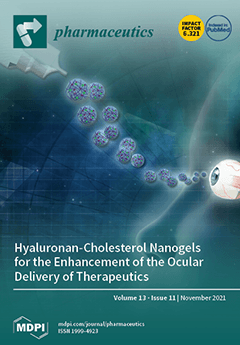Pharmaceutics, Volume 13, Issue 11 (November 2021) – 244 articles
Hyaluronan-cholesterol nanogels (NHs) have been revealed to be effective ocular permeation enhancers. Owing to their bioadhesive properties, NHs firmly interact with the superficial corneal epithelium, without penetrating the stroma, thus modifying the transcorneal penetration of loaded therapeutics, as well as hydrophilic and hydrophobic therapeutics.
Therefore, NHs formulations can improve the ocular bioavailability of the instilled drugs, thus driving the application of HA-based NHs in the treatment of eye diseases. View this paper
- Issues are regarded as officially published after their release is announced to the table of contents alert mailing list.
- You may sign up for e-mail alerts to receive table of contents of newly released issues.
- PDF is the official format for papers published in both, html and pdf forms. To view the papers in pdf format, click on the "PDF Full-text" link, and use the free Adobe Reader to open them.






